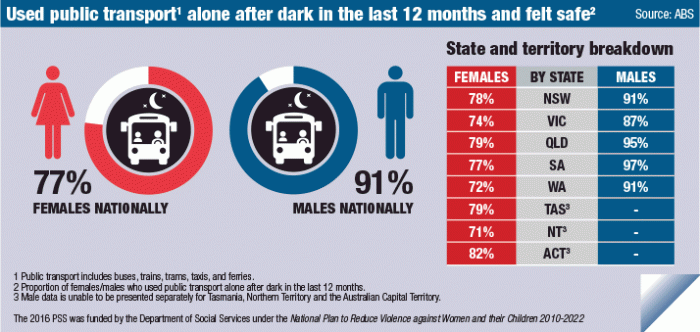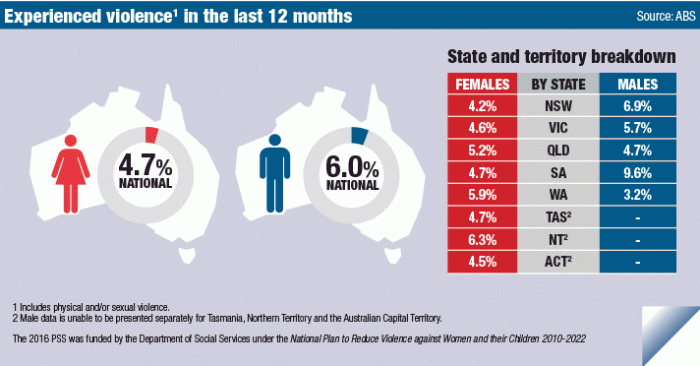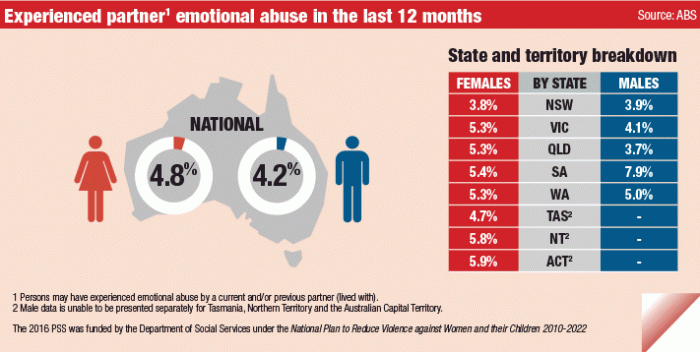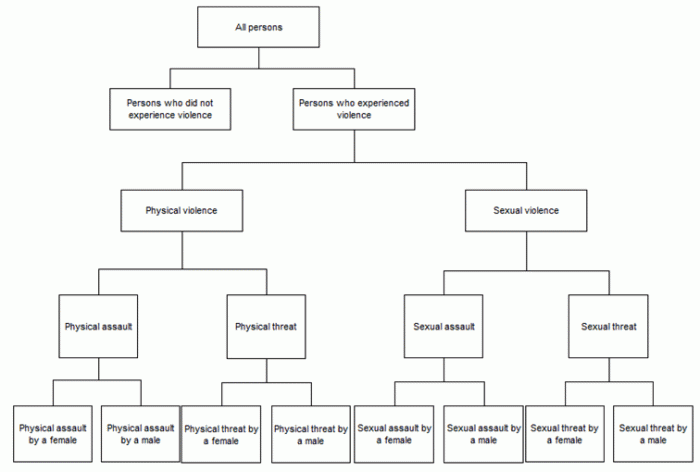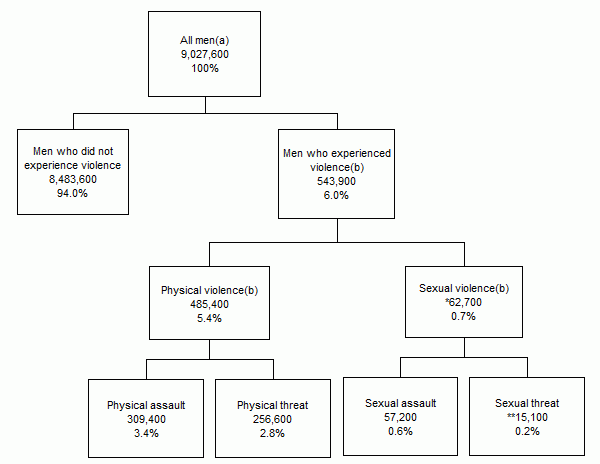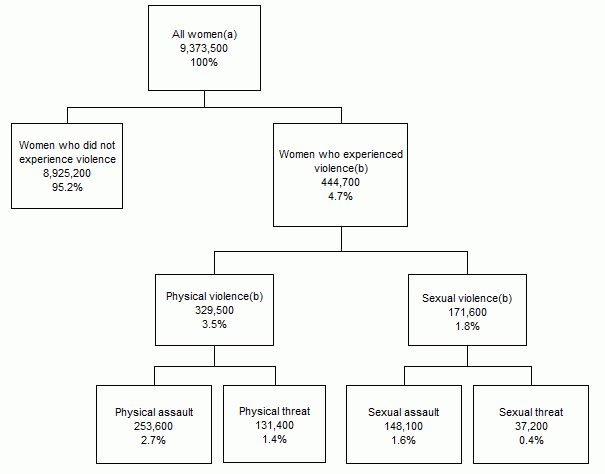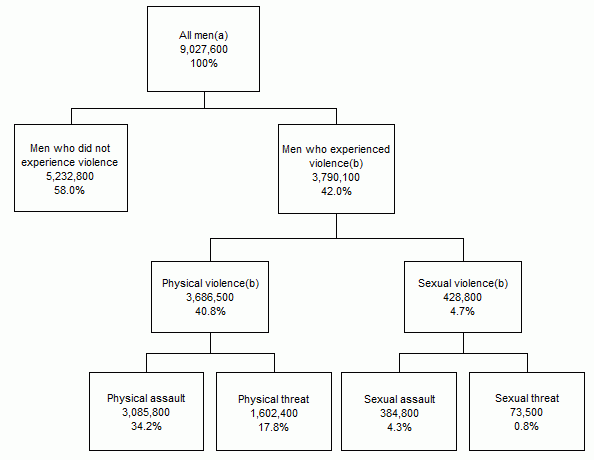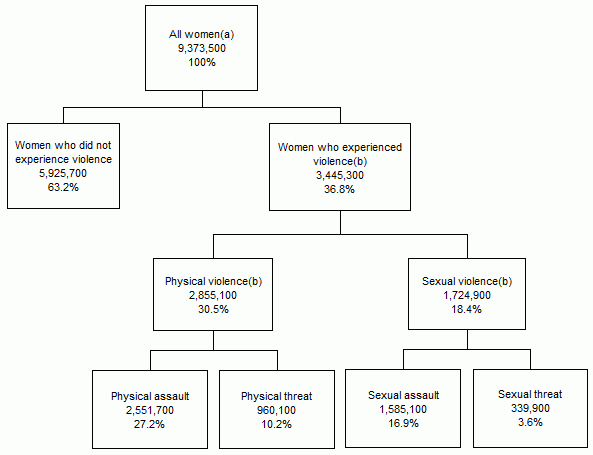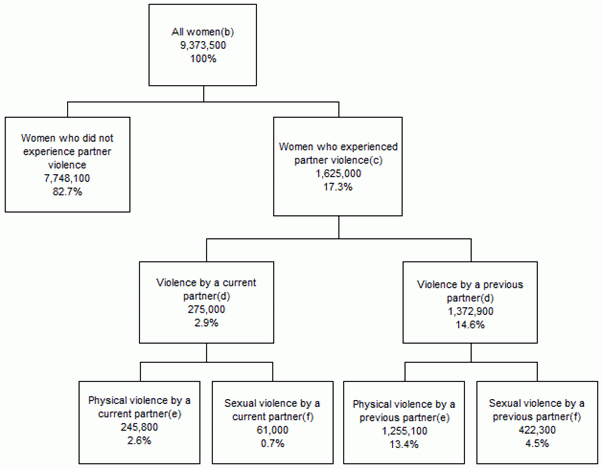This release presents information from the Australian Bureau of Statistics’ (ABS) 2016 Personal Safety Survey (PSS).
The survey collected information from men and women aged 18 years and over about the nature and extent of violence experienced since the age of 15. It also collected detailed information about men's and women's experience of:
- current and previous partner violence and emotional abuse since the age of 15
- stalking since the age of 15
- physical and sexual abuse before the age of 15
- witnessing violence between a parent and partner before the age of 15
- lifetime experience of sexual harassment
- general feelings of safety.
Experiences of violence
Prevalence of violence since the age of 15
Image
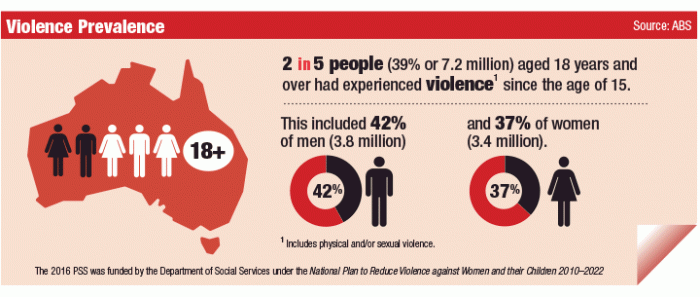
Description
Two in five people (39% or 7.2 million) aged 18 years and over experienced an incident of physical or sexual violence since the age of 15, including 42% of men (3.8 million) and 37% of women (3.4 million).
Four in ten men (41% or 3.7 million) and three in ten women (31% or 2.9 million) experienced physical violence.
One in five women (18% or 1.7 million) and one in twenty men (4.7% or 428,800) experienced sexual violence.
For a definition of violence see Endnote 1.
Changes in violence prevalence rates over time
The proportion of Australians experiencing violence in the last 12 months, has declined over the last decade, decreasing from 8.3% in 2005 to 5.4% in 2016. This decline was driven by a drop in experiences of physical violence, falling from 7.5% in 2005 to 4.5% in 2016.
For men the proportion experiencing physical violence in the last 12 months has almost halved since 2005, decreasing from 10% in 2005 to 5.4% in 2016. For women, the proportion has fallen from 4.7% in 2005 to 3.5% in 2016.
Over a shorter time period, since 2012, the proportion of men experiencing physical violence in the last 12 months decreased, falling from 8.5% in 2012 to 5.4% in 2016. The proportion of women experiencing physical violence in the last 12 months decreased from 4.6% in 2012 to 3.5% in 2016.
The proportion of women experiencing sexual violence in the last 12 months has remained steady between 2005 and 2016 (1.6% in 2005 compared to 1.8% in 2016). However since 2012, there has been an increase, from 1.2% in 2012 to 1.8% in 2016.
Prevalence of violence since the age of 15 - relationship to perpetrator
More than one in three Australians experienced violence by a male perpetrator since the age of 15 (36% or 6.7 million), compared to one in ten by a female perpetrator (11% or 2 million).
Approximately one in four women (23% or 2.2 million) experienced violence by an intimate partner, compared to one in thirteen men (7.8% or 703,700). Endnote 2
More than one in four men (27% or 2.5 million) experienced violence by a stranger, compared to one in eleven women (9.4% or 880,800).
Most recent incident of violence experienced since the age of 15
Detailed information was collected on the most recent incident for some types of violence, but only if the incident occurred less than 10 years prior to the survey.
Men’s and women’s most recent incident of physical assault by a male
- In the most recent incident of physical assault by a male, men were most likely to be physically assaulted by a male stranger (66% or 873,100).
- The location of the incident was most likely to be either a place of entertainment or recreation venue (28% or 370,700) or an outside location (28% or 370,500).
- In the most recent incident of physical assault by a male, women were most likely to be physically assaulted by a male that they knew (92% or 977,600).
- The location of the most recent incident was most likely to be in their home (65% or 689,800).
- Two-thirds of men and women who experienced physical assault by a male did not report the most recent incident to police (69% or 908,100 for men and 69% or 734,500 for women).
Men’s and women’s most recent incident of physical assault by a female
- For both men and women who were physically assaulted by a female, the most common location where the most recent incident occurred was in their home (55% or 286,200 for men and 30% or 98,700 for women).
Women’s most recent incident of sexual assault by a male
- In the most recent incident of sexual assault by a male, women were most likely to experience sexual assault by a male they knew (87% or 553,700).
- The location of the most recent incident was most likely to be in the respondent’s home (40% or 252,400) or in the perpetrator’s home (17% or 109,400).
- The majority of women (9 out of 10) did not contact the police (87% or 553,900).
Partner violence
Image
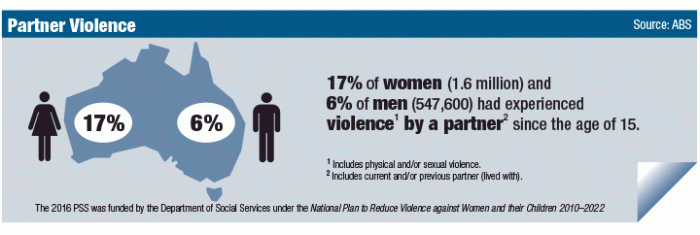
Description
In-depth information about men’s and women’s experience of violence by a partner since the age of 15 was collected in the PSS. Endnote 3
- Women were nearly three times more likely to have experienced partner violence than men, with approximately one in six women (17% or 1.6 million) and one in sixteen men (6.1% or 547,600) having experienced partner violence since the age of 15.
- One in six women (16% or 1.5 million) and one in seventeen men (5.9% or 528,800) experienced physical violence by a partner.
- Women were eight times more likely to experience sexual violence by a partner than men (5.1% or 480,200 women compared to 0.6% or *53,000 men).
* Estimate has a relative standard error of 25% to 50% and should be used with caution.
Changes in partner violence prevalence rates over time
The proportion of women who experienced partner violence in the previous 12 months has remained relatively stable over the last decade. In 2005, approximately 1.5% of women aged 18 years and over experienced partner violence in the previous 12 months, whilst in 2016 the figure was 1.7%.
The proportion of men who experienced partner violence in the previous 12 months increased between 2005 and 2016. In 2005, approximately 0.4% of men aged 18 years and over experienced partner violence in the previous 12 months, whilst in 2016 the figure was 0.8%. However since the survey was last conducted in 2012, there was no significant change in the proportion of men who experienced partner violence (0.6%).
Partner emotional abuse
Image
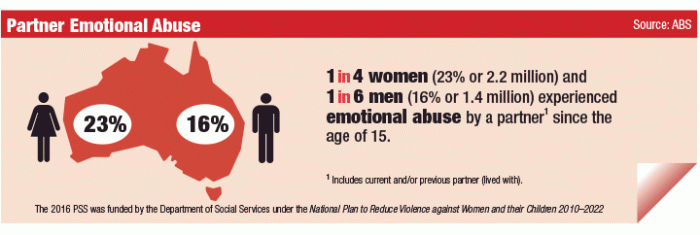
Description
The 2016 PSS collected information about men’s and women’s experiences of emotional abuse by a current and/or previous partner since the age of 15. Endnote 4
- One in four women (23% or 2.2 million) and one in six men (16% or 1.4 million) reported experiencing emotional abuse by a current and/or previous partner since the age of 15.
Abuse before the age of 15
Image
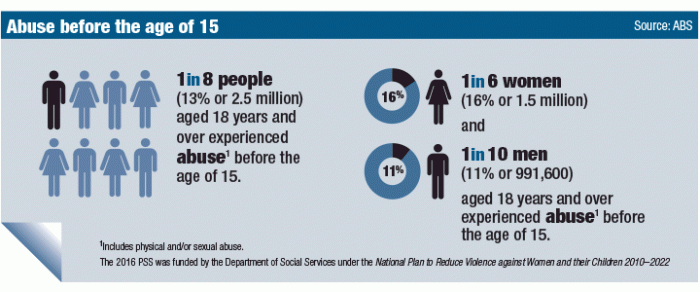
Description
The 2016 PSS collected information about men’s and women’s experiences of physical and/or sexual abuse before the age of 15 years by any adult (male or female), including the person’s parents.
- One in six women (16% or 1.5 million) and one in ten men (11% or 991,600) aged 18 years and over experienced abuse before the age of 15.
Witnessed violence before the age of 15
The 2016 PSS asked respondents if they ever heard or saw violence (physical assault) being directed at one parent by another before the age of 15.
- One in ten men witnessed violence towards their mother by a partner before the age of 15 (10% or 896,700) and one in twenty-five men witnessed violence towards their father by a partner before the age of 15 (4% or 380,000).
- One in eight women witnessed violence towards their mother by a partner before the age of 15 (13% or 1.2 million) and one in twenty women witnessed violence towards their father by a partner before the age of 15 (4.7% or 440,900).
Sexual harassment
Image
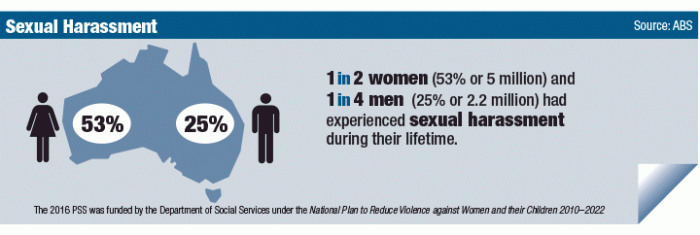
Description
The 2016 PSS collected information about men’s and women’s lifetime experiences of sexual harassment. Endnote 5
- Two in five people (39% or 7.2 million) aged 18 years and over experienced sexual harassment during their lifetime.
- One in two women (53% or 5 million) and one in four men (25% or 2.2 million) had experienced sexual harassment during their lifetime.
- In the last 12 months, one in six women (17% or 1.6 million) and one in eleven men (9.3% or 836,700) experienced sexual harassment.
- For both men and women, younger age groups were more likely than older persons to experience sexual harassment in the 12 months. Approximately 38% of women (421,400) and 16% of men (185,200) aged 18-24 years had experienced sexual harassment in the 12 months prior to the survey.
Changes since 2012 (endnote 6)
- The proportion of women experiencing sexual harassment in the 12 months prior to the survey has increased from 15% in 2012 to 17% in 2016.
- The proportion of men experiencing sexual harassment in the 12 months prior to the survey has increased from 6.6% in 2012 to 9.3% in 2016.
Stalking
Image
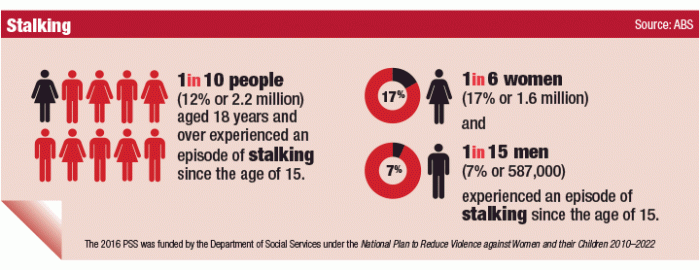
Description
The 2016 PSS collected information about men’s and women’s experiences of stalking since the age of 15. Endnote 7
- The 2016 PSS found that one in six women (17% or 1.6 million) and one in fifteen men (6.5% or 587,000) experienced an episode of stalking since the age of 15.
